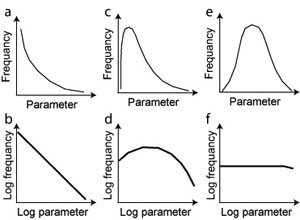| |||||||
|
|
|||||||
|
|
|||||||
| Geostatistical Properties | |||||||
|
In the published literature, field, experimental, or numerical data sets on statistics and scaling of fractures are commonly presented either in frequency versus size, a measured dimensional parameter, on normal scale, or logarithmic scale. The most common distribution forms aside from linear forms in regular distributions are summarized in Figures 1(a) to (f). Although rare, semi-logarithmic plots are also used. Regular Frequency-size (any dimension) plots generally fall into three forms; power-law (a), log-normal (c), and normal (e). The same data when viewed in log/log plot will appear in the forms shown in (b), (d), and (f), respectively. However, we should note that it is not always trivial to identify these forms. Given that most data sets collected from natural fractures have some ambiguities due to the observational and measurement limitations, it is challenging to determine the natural fracture distribution forms. Nevertheless, distributions and scaling of each of the four major structures and their sub-classes such as zones, sets, multiple sets, and domains are presented in this Knowledgebase. | |||||||
| Types of Geostatistical Properties: | |||||||
| Geostatistical Properties of Fracture ElementsGeostatistical Properties of Fracture ZonesGeostatistical Properties of Fracture SetsGeostatistical Properties of Fracture Multiple Sets | |||||||
| Reference: |
|||||||
| Bonnet, E., Bour, O., Odling, N. E., Davy, P., Main, I., Cowie, P.A., Berkowitz, B., 2001 Rives, T., Razack, M., Petit, J.P., Rawnsley, K.D., 1992 |
|||||||
|
Readme | About Us | Acknowledgement | How to Cite | Terms of Use | Ⓒ Rock Fracture Knowledgebase |
|||||||
